

Kilts and more. ScottishHistory.com. Ewan J.

Innes, MA(Hons Scot. Hist.) FSA Scot Synopsis: This essay describes the reason why other than nineteenth century migration, there are no O' surnames in Scotland, but there are Mac surnames in Ireland. This debunks the myth that Mac is Scottish and Mc is Irish. Please see my copyright policy if you wish to cite any part of this essay. Firstly, it is complete and utter nonsense that Mac and Mc indicate Scottish or Irish origins. There is however one distinction you can make as far as differentiating between a name being Scottish or Irish.
Irish legal tracts of the fifth century recognise 3 grades of kingship: rí túathe - ruler of kindred rí túath - Overlord of other kindreds - also ruire (ro aire) rí ruirech - king of overkings - also rí cóicid - king of a fifth (e.g.. king of Munster) The above grades are purely legal, in the Irish annals they are simply described as rí - you were supposed to know as you read the annal which grade a particular king belonged to. MacRae Clan Homepage Scottish Clans Tartans Kilts Crests and Gifts. Doric Dialect Accent Scotish Words and Phrases. Play our new game - Whack The Haggis!!
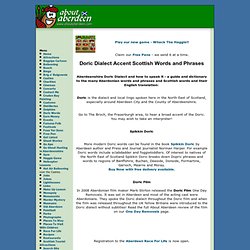
Claim our Free Pens - we send 6 at a time. Aberdeenshire Doric Dialect and how to speak it - a guide and dictionary to the many Aberdonian words and phrases and Scottish words and their English translation: MacRae Tartans. Scotland. Hailes (ball game) Hailes or clacken is a Scottish ball game which dates to the 18th century and achieved its widest popularity in the nineteenth.
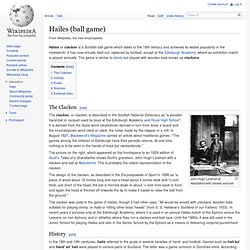
It has now virtually died out, replaced by football, except at the Edinburgh Academy, where an exhibition match is played annually. The game is similar to shinty but played with wooden bats known as clackens. John Hugh Lockhart at Abbotsford with clacken and ball. Kilt. One of the earliest depictions of the kilt is this German print showing Highlanders in about 1630 The kilt is a knee-length garment with pleats at the rear, originating in the traditional dress of men and boys in the Scottish Highlands of the 16th century.

Since the 19th century it has become associated with the wider culture of Scotland in general, or with Celtic (and more specifically Gaelic) heritage even more broadly. It is most often made of woollen cloth in a tartan pattern. Although the kilt is most often worn on formal occasions and at Highland games and sports events, it has also been adapted as an item of fashionable informal male clothing in recent years, returning to its roots as an everyday garment. Tartan. Tartan is a pattern consisting of criss-crossed horizontal and vertical bands in multiple colours.
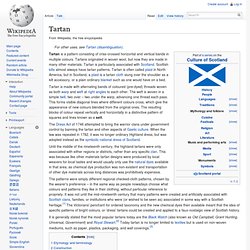
Tartans originated in woven wool, but now they are made in many other materials. Tartan is particularly associated with Scotland. Scottish kilts almost always have tartan patterns. Sport in Scotland. Sport plays a central role in Scottish culture.
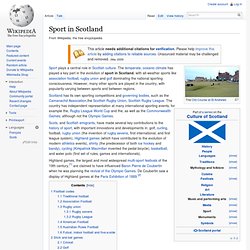
The temperate, oceanic climate has played a key part in the evolution of sport in Scotland, with all-weather sports like association football, rugby union and golf dominating the national sporting consciousness. However, many other sports are played in the country, with popularity varying between sports and between regions. The Soup Dragons. History[edit] The Soup Dragons formed in Bellshill, a town near Glasgow, in 1985.[1] The line up was Sean Dickson (vocals, lead guitar), Jim McCulloch (guitar, second voice) who replaced Ian Whitehall and Sushil K.
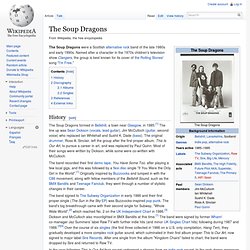
Dade (bass). The original drummer, Ross A. Sinclair, left the group after the first proper album, This Is Our Art, to pursue a career in art, and was replaced by Paul Quinn. Most of their songs were written by Dickson, while some were co-written with McCulloch. Discography[edit] Albums[edit] Singles[edit] References[edit] External links[edit] List of Scottish scientists. Wulver. The wulver is a kind of werewolf that is part of the folklore of the Shetland islands off the coast of Scotland.
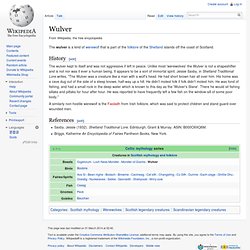
History[edit] The wulver kept to itself and was not aggressive if left in peace. Unlike most 'werewolves' the Wulver is not a shapeshifter and is not nor was it ever a human being. It appears to be a sort of immortal spirit. Jessie Saxby, in Shetland Traditional Lore writes, "The Wulver was a creature like a man with a wolf's head. A similarly non-hostile werewolf is the Faoladh from Irish folklore, which was said to protect children and stand guard over wounded men. Scottish mythology. Overview[edit] Though the Celtic world at its apex covered much of western and central Europe, it was not politically unified nor was there any substantial central source of cultural influence or homogeneity; as a result, there was a great deal of variation in local practices of Celtic religion (although certain motifs, for example the god Lugh, appear to have diffused throughout the Celtic world).
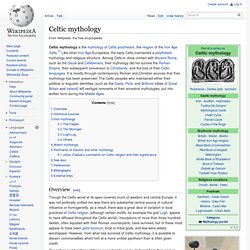
Inscriptions of more than three hundred deities, often equated with their Roman counterparts, have survived, but of these most appear to have been genii locorum, local or tribal gods, and few were widely worshipped. However, from what has survived of Celtic mythology, it is possible to discern commonalities which hint at a more unified pantheon than is often given credit. Doric dialect (Scotland) Doric, the popular name for Mid Northern Scots[1] or Northeast Scots,[2] refers to the dialects of Scots spoken in the northeast of Scotland.
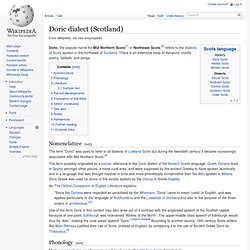
There is an extensive body of literature, mostly poetry, ballads, and songs. The term "Doric" was used to refer to all dialects of Lowland Scots but during the twentieth century it became increasingly associated with Mid Northern Scots.[3] Edinburgh. Edinburgh. Roamin' in the Gloamin'", Harry Lauder with orchestra.